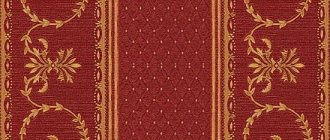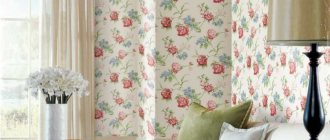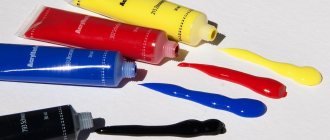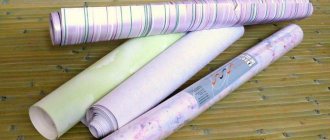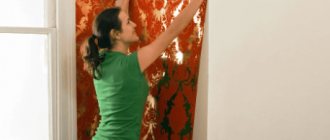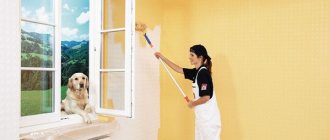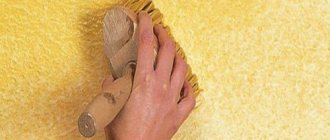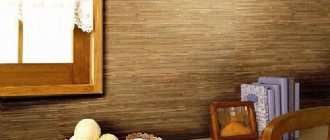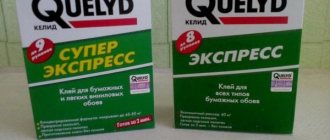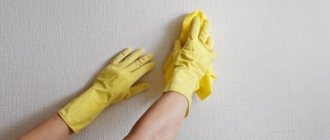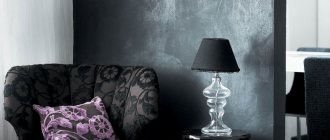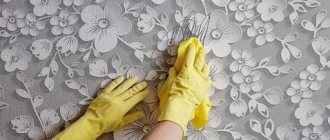When doing cosmetic repairs yourself, you will most likely encounter wallpapering. When choosing, you should be guided not only by the aesthetic beauty of the design, but also by the characteristics of the paintings. A fresh renovation will please you for as long as possible if you pay attention to the characteristics of the wallpaper, the rules of its operation and installation information.
Manufacturers indicate all this data directly on the rolls in the form of small pictograms with, as a rule, a meager description.
Knowing how to read this information correctly will help you choose the most suitable wallpaper for your renovation. Let's figure out what's what
Why do you need wallpaper labeling?
Deciphering the characteristics of the product on the roll makes it possible to thoughtfully choose the material for pasting any room. Products have a wide range, which can lead to the risk of choosing a product whose properties are not suitable for a specific apartment or office. In the future, an unsuccessful purchase may lead to the wallpaper peeling off, and the repair will need to be done again.
Before starting finishing projects, you need to take seriously not only the designers’ advice on the color and pattern of wallpaper that suits the interior, but also their structure. You should draw up a plan in advance, a bill of materials for the project, select designer chairs and furniture to match them, make drawings and visualizations in the form of collages in order to be able to make edits before you start gluing the canvases.
To get the job done right the first time and not have to redo it, you should carefully study the label on each roll before purchasing wallpaper. There you can see different small icons that will help you choose the right canvas. This information will make the decision much easier, help you correctly calculate the exact amount of material, and will also help you save money and time on the project.
International marks of quality and environmental friendliness
Large manufacturers additionally apply identification marks of international organizations on the packaging that test finishing materials and other products for compliance with technical and environmental quality standards. International markings on wallpaper confirm that they are safe for the human body.
| Photo | Description |
| The CE mark confirms product compliance with European safety standards for consumer health. The height of the pictogram should not be less than 5 mm. The color and method of application are chosen by the manufacturer. | |
| The international FSC certificate is issued to companies that use materials from certified wood from responsible forests in the production of wallpaper. | |
| The RAL quality mark is applied to products that meet high environmental safety standards. Certification places high demands on samples and testing protocols. | |
| The Blue Angel sign appears on many products, including wallpaper. This is a German quality standard regarding the environmental friendliness of manufactured products. | |
| The “European Flower” marking refers to the marks of the European Union countries. When making paper, a number of requirements are imposed on the fiber, production technology, substances used and packaging. |
Letter designations
Sometimes the full composition of materials is indicated on the rolls, but more often there is a letter marking with the following designations:
- A. Acrylic. A paper-based product with acrylic foam on the top layer.
- B. Paper. The cheapest wallpaper available to everyone. There are single-layer, multi-layer and washable products.
- BB. Foamed vinyl. The surface of this material is voluminous and textured.
- PV. Flat vinyl. These are vinyl products with a flat relief that have undergone additional pressing.
- RV. Embossed vinyl. Products made of vinyl and having a non-woven base and a relief pattern.
- PAGE Structural for painting. The material they are made of is paper or non-woven fabric; they have a structured relief and require additional coloring.
- STL. Glass wallpaper. Made of fiberglass and have high environmental friendliness, strength and fire safety.
- TKS. Textile. Products based on fabric fibers.
Such letter designations are necessary to choose the best canvas for a particular room. Paper products are definitely not suitable for the kitchen, since they will not last long there. This coating is more relevant for a bedroom or nursery in two-room or three-room apartments.
Vinyl and non-woven wallpapers are characterized by increased strength and resistance to moisture, and their textured surface will fit well into designs in various styles: Scandinavian, classic, euro, minimalism, art, hi-tech and others. Stylish designer chandeliers will look good on the ceiling in such rooms.
Fiberglass wallpaper is the most durable and safe; it is good to glue it in a house with small children and animals.
How to decipher the symbols on wallpaper: guide from ReRooms
Do you want to buy wallpaper to renovate your apartment, but don’t know what the numerous symbols on the roll packaging mean? Now we will explain everything to you!
The wallpaper packaging contains not only its name and a beautiful picture of the surface of the canvas. There is also a lot of useful and important information for the buyer - in the form of symbols and small drawings.
And these designations on the wallpaper must be studied, otherwise there is a risk of purchasing finishing materials that, according to their characteristics, are not at all suitable for your home.
The result may be a complete replacement of the wallpaper in the room.
That is why we will decipher for you all the symbols and signs that are found on the rolls. After reading the article, you will be able to read any icons on the wallpaper - and this will help you buy in the store exactly the material that is best suited for your apartment.
Moisture resistance
Let's move on to graphic symbols. They all have a black and white schematic appearance, so if you don’t know the exact meaning of the picture, it can be difficult to decipher such symbols.
homerenovates.com
Let's start with the moisture resistance of the wallpaper. This mark will let you know whether the selected wallpaper can be washed, and if so, how. There are several degrees of wallpaper resistance to water:
- moisture-resistant - such wallpaper cannot be washed with large amounts of water, but can be wiped with a damp soft cloth;
- washable - such wallpaper can already be washed with any amount of water and a sponge. There will definitely not be such a badge on paper products, only on vinyl or non-woven ones;
- super washable - this means that when washing with water, you can use any chemical cleaning agents;
- with a brush pattern is wallpaper that is resistant to cleaning by friction, that is, not just with a rag or sponge, but with a brush with stiff bristles. There is a second variety - super-resistant, which can be cleaned with a brush and water;
- super-resistant wallpaper can be different: with one, two or three wavy lines. The more lines, the higher the material’s resistance to water.
Light fastness level
Another important characteristic that you can learn about by deciphering the icons on the wallpaper is their resistance to light and direct sunlight. These symbols will tell you how likely the surface is to fade in the sun.
homerenovates.com
There are five levels of light resistance of wallpaper:
- medium - it is better for such wallpaper not to come into contact with direct sunlight at all, otherwise it will fade quite quickly;
- satisfactory - rays can reach the surface, but partial loss of color and saturation cannot be ruled out during prolonged exposure;
- good - the most common and popular type, which guarantees good tolerance of light falling on the surface;
- very good, excellent - two improved types of wallpaper that can be glued in rooms with panoramic windows or, for example, with a transparent glass ceiling.
Pasting method
The rolls also contain instructions on exactly how to install the wallpaper on the walls of the apartment.
homerenovates.com
This information can be deciphered using the corresponding symbols:
- glue is applied to the wall;
- glue is applied to the wallpaper, on its back side;
- self-adhesive - the glue is already applied to the wallpaper, you just need to wet the wallpaper and remove the protective film;
- special glue is required - this means that to glue the canvas you will need a special solution.
Instructions for joining the pattern
If you buy material decorated with a design or pattern, deciphering the signs on the wallpaper will help you correctly join the strips from the roll.
homerenovates.com
There are several types of docking:
- random gluing - this designation can be found on wallpaper either without patterns or with a small pattern that does not need to be joined;
- symmetrical arrangement of the pattern - this marking indicates the need to clearly adjust strips of equal length to each other;
- opposite arrangement - in order to join a geometric pattern or other pattern, each subsequent strip must be glued “upside down”, rotated 180 degrees;
- shifting location - this means that in order to join the pattern you need to slightly raise or lower the level of the next strip. On such rolls there are also two numbers indicated in the form of a fraction - they help to understand how much the canvas needs to be shifted.
Read also Decoupage of old furniture with wallpaper
bestuserschoice.com
Decoding the symbols on the wallpaper will help you get additional information, including about the environmental class of the material, the wallpaper's resistance to fire or mechanical damage.
Moisture resistance
If in the future you plan to wash the wallpaper or the product will be located in rooms with high humidity, you should choose rolls with a “wave” mark. Also, using this marking you can determine what kind of care is acceptable for the product:
- One wave means that the product can be glued in rooms with high humidity. Fresh stains on them can be removed with a damp sponge without any special products.
- Two waves indicate washable material. You can clean the canvas with a damp sponge and mild detergents; grease and oil stains will not be removed.
- Three waves allow wet cleaning using any detergents, with the exception of abrasive ones.
- The brush implies the ability to clean the sheet with a dry brush.
- One wave and brush mean wear resistance of the material. The product is cleaned using a damp sponge or brush.
- Three waves and a brush indicate cleaning from any dirt. In this case, you can use a soap solution, a brush, water, as well as weak and abrasive detergents.
You should pay attention to such wallpaper when decorating walls in the kitchen, bathroom or combined bathroom.
A number of icons on the rules of pasting
The picture shows a bowl with a strip of wallpaper lowered into it; this finishing material is already saturated with glue. Before gluing the strips you just need to wet them with water.
The sign - in a square with an arrow pointing upward - indicates the direction of location on the wall.
If the two arrows are pointing upward, all wallpaper strips must be glued in the same direction.
The indicators are depicted: one is directed upwards, and the other is directed downwards. This means that such strips should be glued according to the scheme: one strip, as usual, and the second must be turned over.
The designation on the wallpaper - in the square, the arrow points down and rests on a flat strip - this is an indication that the pasting should be done parallel to the bottom of the room or the ceiling.
The square is divided in half and lengthwise by a line, one arrow faces the other - a warning that it is necessary to join the drawing. If the arrow points to zero, then alignment is not required.
When one arrow is higher and the second is lower, it means that you need to select a pattern. And with all this, it is also shifted by several centimeters. Accordingly, more rolls of wallpaper will be needed than the calculated amount.
The square is divided diagonally, in the upper and lower corners of the number. This indicates that the drawing is shifted by the value of the first digit, and on the next canvas there will be a shift by the value of the bottom one.
Light fastness level
This marking indicates resistance to sunlight. Graphic images on labels come in the following varieties:
- Half sun. Low light fastness. The colors on the canvas will be bright only in darkened rooms or in the case of windows facing north.
- Half sun and plus sign. The level of light fastness is average. The color of the wallpaper will gradually fade.
- Full circle of the sun. The level of light fastness is high. The products are suitable for gluing in bright rooms. They are able to retain color for a long time.
- Solar circle with a plus sign. Excellent light fastness. The product can be exposed to the sun all year round with long-term preservation of its original brightness.
- Two suns. Excellent light fastness. The color is preserved and does not fade throughout the entire period of use of the canvas.
If the windows face the sunny side, it is worth choosing wallpaper with suitable markings to avoid the risk of fading of the products. In a shaded hallway, you can glue wallpaper with low light resistance. In the living room and room with large panoramic windows, it is better to choose the best light resistance, otherwise they will fade in a couple of years.
Symbols and their meanings
Here are a few basic symbols on vinyl wallpaper for walls:
- Water resistance is indicated by a curved line. One such wave - the remaining glue when gluing needs to be removed with a damp cloth. Double line - washing can be done with a cloth and simple detergents. The triple line is super washable, the surface of which is especially resistant to washing.
- Resistance to mechanical damage – brush icon. If it is shown alone - no water used, no brush and a curved line - you can use a wet brush. If a brush with a triple wave is drawn, it is a wear-resistant material.
- Fade resistant - sun icon. Half of it is a fairly light-resistant material, half plus is relatively light-resistant, only the sun is resistant, sun plus and two suns are good and the highest level of light fastness.
Other drawings make it possible to understand what glue can be used, what method to use for gluing or removing wallpaper, and so on.
As you can see, there are many materials available for walls; symbols printed on rolls of non-woven, vinyl, paper and other wallpapers allow you to understand their properties. This makes it possible to make a more informed choice of the optimal material that will serve for many years with the necessary aesthetic and performance qualities.
- bedroom
- bathroom
- hall
- kitchen
- living room
- children's
- hallway
- combined
- photo wallpaper
- non-woven
- washable
- liquid
- for painting
- vinyl
- paper
- 3d
- colors
- Preparation
- sticking
- glue
- cornices
- the shops
Marking by joining the pattern
It is not always possible to understand from the pattern on the canvas how to fit the sheets to each other. Manufacturers, using clear images in the form of arrows, make it clear how the sheets should be arranged:
- arrow with an upward direction - all canvases must be glued in the same direction;
- vertical arrows pointing in different directions - counter joining, every second panel must be turned 180°.
- arrows “looking” at each other – the overlay of the pattern on the sheets is made symmetrically;
- horizontal arrows at different levels - the drawing on the next sheet should be shifted by half the height of the drawing on the previous sheet;
- horizontal arrow and zero – arbitrary sticker;
- two lines horizontally and one vertically - for invisible joining, the sheets should be glued with an overlap, and then a cut should be made along the seam.
If you adhere to the marking recommendations, matching the pattern on the wallpaper will not be difficult.
Dismantling of canvases.
Why is it important? Not for the next renovation, of course, although... There are situations when we know that we will have to remove the wallpaper after gluing it. For example, in a new house, cracks may appear in the putty when the house shrinks - this is a completely normal situation. In such cases, the canvas is peeled off, the cracks are rubbed out and re-gluing is performed.
- Completely removable . During dismantling, they are completely removed from the wall.
- Partially deleted . The top layer is removed immediately, but the second layer remains on the wall; to dismantle it you need water and a scraper or spatula.
- Removal using tool . The wallpaper is removed in one layer using a scraper.
Designations for installation and dismantling of the canvas
In gluing technology, the main thing is the method of applying the glue. On rolls this is indicated by one of three images:
- vertical line with a brush - glue must be applied to the wall;
- roll with a brush - glue should be applied directly to the canvas;
- container with liquid and roll - a layer of glue is applied to the wallpaper, which will be ready for processing after wetting with water.
To remove wallpaper, symbols are used to indicate the features of dismantling:
- brush between thick and thin vertical lines - removed after applying liquid to the canvas;
- arrow next to a thin vertical line - removed without wetting;
- the vertical line is divided into two - the material should be removed layer by layer.
Understanding the labeling of wallpaper will not be difficult. By following the recommendations, you can easily choose the material for pasting both a one-room apartment and a large country house. Well-chosen wallpaper will delight family members and will last for a long time.
Useful tips for choosing wallpaper
If you need wallpaper for walls in a public space, look for rolls with the crossed out fire icon. It is installed in cases where the canvases have a highly flammable coating.
Otherwise, in addition to the icons on the wallpaper, be sure to make sure that the batch number and article number on all rolls match. In different batches, the color of the rolls may differ slightly; it is difficult to notice in the store, but in daylight the difference will be very noticeable.
Table of symbols on wallpaper
Calculation with drawing adjustment
Wallpaper with complex or large patterns requires adjustment, so the calculation will be different. The length of the strip must exceed the height of the room and be a multiple of the repeat (pattern step).
Let's analyze the calculation procedure for the same room (perimeter - 18 m, ceiling height - 2.5 m). Roll width – 53 cm, length – 10 m, repeat – 38 cm.
- The strip length is calculated as follows. Divide the height of the room by the rapport value (2.5: 0.38 = 6.6). Round the resulting number up to the nearest whole number. In our case it will be 7. We multiply the image pitch value by the resulting number (0.38 × 7 = 2.66 m). Now we divide the length of the roll by the existing result (10: 2.66 = 3.8). Round to the nearest whole number, but downwards. It turns out that the roll is enough for 3 cuts, the rest is forced losses.
- Next, we calculate the number of tubes. First, we find the number of strips; to do this, we divide the perimeter by the width of the roll, as in the first case (18: 0.53 = 34, rounded). Now we divide the resulting value by the number of stripes in the tube (34: 3 = 12, rounded). Our room will require 12 rolls.
USEFUL INFORMATION: DIY soft panels for walls
As you can see, the difference between the number of wallpapers with a pattern without matching and an image that requires adjustment is as much as 3 tubes.
Ecolabel
Leading wallpaper manufacturers are trying to produce exclusively environmentally friendly materials to ensure the safety of people during use of the canvases. To obtain the appropriate certificate, products are tested and tested in laboratory conditions. If the outcome of the checks is positive, then the manufacturer is issued a certification document confirming the safety of wall finishing products.
Today, on rolls of modern building materials you can see the following types of eco-labels:
- Russian;
- the official sign of the Scandinavian countries is “Nordic Ecolabel”;
- “Organic Eurolist”, “Ecolabel” - European quality marks;
- German environmental certificate - “Der Blaue Engel”;
- German forestry company – FSC;
- English certification company – MSC
There are other eco-brands that may also be listed, but these are considered the most common. If there are similar differences on the rolls, then you can safely buy such wallpaper and not be afraid that it can harm your health.
Dealing with pictograms on wallpaper is not difficult. Each graphic illustration indicates one or another characteristic of the panel. By paying attention to the images, you can easily select products that meet all your requirements. Often products are indicated by four icons, and this is quite enough.
It is worth understanding that each type of wallpaper can be pasted using a different method, the same applies to dismantling. Experts advise buying trellises in accordance with the place where they are glued.
Features of gluing wallpaper with a pattern
Working with printed wallpaper has its own nuances. Knowing these features will help you avoid mistakes, such as pattern inconsistencies.
- When purchasing material, it is taken into account that the amount of waste will increase due to the need to combine the pattern. Therefore, you need to take rolls with a reserve. Knowing the repeat pitch, you can calculate the required number of tubes most accurately.
Advice. To significantly reduce the share of waste, it is recommended to cut pieces from different rolls when selecting a pattern.
- For perfect alignment of the image, be sure to leave allowances of several centimeters at both ends of the strip.
- During gluing, special attention is paid to the joints.
USEFUL INFORMATION: Original solutions for walls to be painted in the interior
